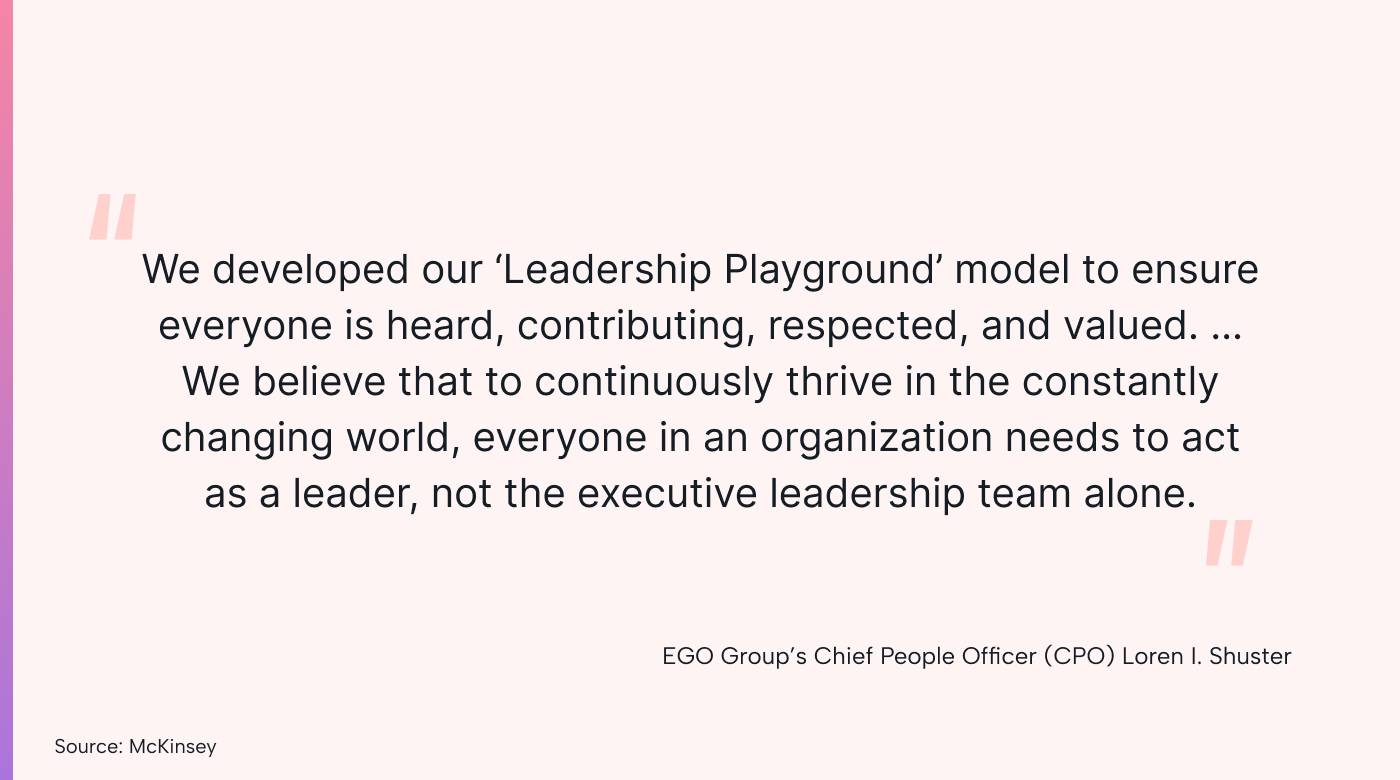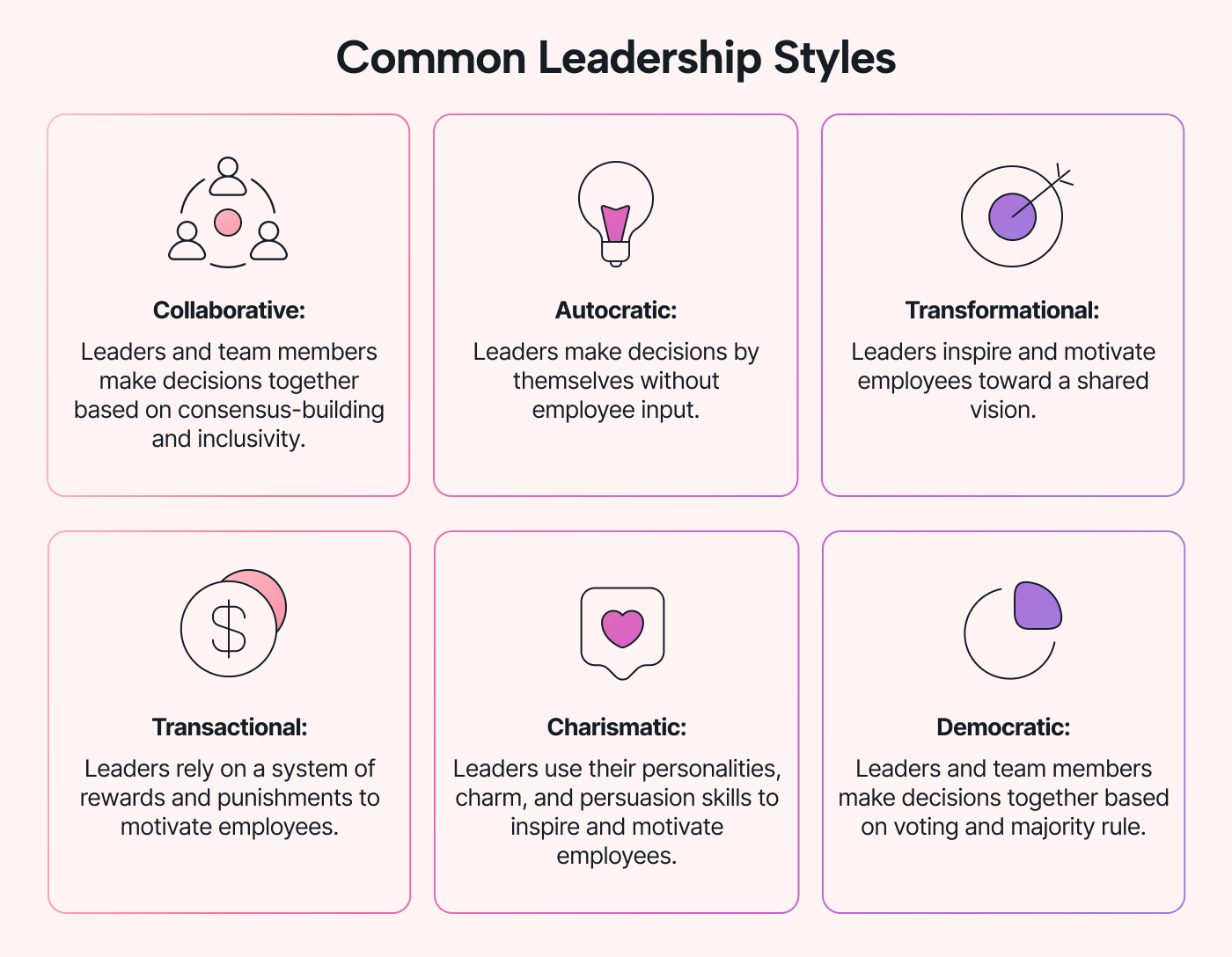Ever wondered how some teams just click? They always deliver projects on time, and they’re always hitting their performance metrics.
That, right there, is what happens when you implement collaborative leadership. Unlike conventional leadership styles, a collaborative approach brings diverse minds together and creates a collective front where everyone’s on board with a shared vision.
So, how can you embody collaborative leadership and weave its magic into your team?
In this article, we peel back the layers of collaborative leadership, explain why it’s important, pit it against other leadership styles, and arm you with actionable tips to get the ball rolling.
What is collaborative leadership, and why is it important?
Collaborative leadership is a management approach where everybody shares in the decision-making process — leaders and team members alike. It’s a refreshing shift from top-down management, but more importantly, it serves as a remedy for common workplace issues.
What issues, you ask?
Well, let’s take a look at the current state of leadership: 56% of American workers think their boss is toxic, and 75% cite them as a primary source of stress. Certainly no one aspires to be that kind of boss, but it can happen when leaders aren’t paying attention.
However, collaborative leadership is about more than just becoming a better leader.
When you implement a culture where everyone gets a say, it:
- Creates a feeling of transparency
- Builds trust
- Fosters innovation
- Improves employee engagement and morale
These elements not only reduce workplace stress but also bring along additional benefits, which we’ll explore below.
Benefits of collaborative leadership
As collaborative leadership is becoming popular in the modern workspace, let’s unpack the benefits it brings to the table:
1. Enhanced team cohesion
A collaborative approach to leadership is about building a team where everyone’s input isn’t just heard — it’s sought after and respected. By involving everyone in decision-making, it creates an environment not only of belonging and commitment but also of mutual respect and trust. The result? A team that sticks together, even amidst challenges.
2. Increased innovation and creativity
Valuing diverse perspectives and encouraging open communication can lead to new ideas and innovative solutions to problems. Teams are more likely to think creatively and contribute their ideas in such a collaborative environment.
The LEGO Group, a globally celebrated brand synonymous with creativity, fully embodies this. Their Chief People Officer (CPO), Loren I. Shuster, shares:
 |
Considering that LEGO is one of the world’s most iconic brands with revenues that continue to grow, it’s clear that this model isn’t just enjoyable — it’s powerfully effective.
3. Improved job satisfaction and employee morale
Employees thriving in their roles often work in environments where their voices are valued. This boosts engagement, which should be the goal of every manager. Workplace research shows that 74% of employees feel more engaged when they believe their ideas are welcome.
Because collaborative leadership creates such an inclusive environment, more team members choose to stay, which boosts morale and reduces staff turnover. All of this positively impacts the bottom line, making it a win-win for both the team and the business.
4. Better decision-making
The saying “two heads are better than one” really hits the nail on the head when it comes to effective collaboration. By pooling together different perspectives, decisions become more well-rounded and thought-through. It’s like getting advice from a group of friends instead of just one — chances are you’ll come up with a solution that’s not only effective now but also stands the test of time.
5. Positive organizational culture
Seventy-six percent of employees say an organization’s culture is very important for them to be effective at their jobs. While “respect,” “trust,” and “inclusivity” may pepper corporate dialogue, truly living these values demands a culture of collaboration.
When employees genuinely feel respected, trusted, and included, they’re more likely to feel connected to their organization’s culture. The ripple effects of this connection are compelling. Employees are:
- 3.7 times more likely to be engaged at work
- 5.2 times more likely to recommend their organization as a great place to work
- 68% less likely to experience strong burnout
- 55% less likely to actively look for another job
From less stress to better workplace culture, the benefits of a collaborative leadership style are endless. But is it the right approach in all situations? Let’s find out.
How does collaborative leadership compare to other styles of leadership?
There are many styles of leadership out there, and collaborative leadership is just one of them. Let’s see how it stacks up compared to a few common leadership styles:
Autocratic leadership
Autocratic leaders are the “just let me handle it” kind. While collaborative leaders gather the team for a group brainstorming sessions, autocrats prefer to decide things on their own. This style works best in emergencies or when there’s little time for debates. It’s quick and straightforward but may leave some team members feeling overlooked.
Transformational leadership
Transformational leadership involves inspiring teams with big dreams and innovative ideas — it resembles the motivating energy seen in self-help seminars. On the other hand, collaborative leaders focus on making decisions and solving problems together with their team. If a burst of visionary energy and innovation is needed, transformational leadership can effectively propel a team toward ambitious goals.
 |
Transactional leadership
Transactional leaders are all about “do this, get that” — setting clear rules and dishing out rewards or fixes based on performance. Think of a manager rewarding good performance with a bonus. In contrast, collaborative leaders rally the team around shared goals. Transactional leadership fits the bill if a structured, by-the-book approach is needed.
Charismatic leadership
Much like larger-than-life historical figures, charismatic leaders use their personal charm and persuasive skills to inspire and motivate their followers. Charismatic leaders are great for firing up a crowd and creating momentum, but if they leave, the team might struggle. While their personal allure is pivotal, collaborative leaders leverage collective wisdom by uniting everyone in decision-making.
Democratic leadership
Democratic leaders are like teachers who always ask what the class thinks. They’re big on getting everyone’s two cents and making choices based on what most team members feel is right. While they’re into majority rule, too, collaborative leaders are all about getting everyone to nod in agreement. Need a quick decision after hearing everyone out? Go democratic. But if the journey of making that call together matters most, then collaborative leadership is the way to go.
What are the characteristics of a collaborative leader? (And how to become one)
So, you want to be the kind of leader that brings everyone together to focus on a common goal? Here’s the lowdown on what makes a collaborative leader tick and how to embrace this style:
1. Collaborative leaders build a culture of trust
Trust isn’t just a buzzword — it’s the foundation on which collaborative leaders stand tall. By consistently showing up and proving your reliability, you lay the groundwork for a dependable relationship.
But it’s not just about being consistent.
Embracing vulnerability and championing transparency are important, too. Take a cue from companies like Zapier. On their values page, they’ve got a section named “Default to transparency.” And it’s not just lip service, either — they break down what being transparent means with actionable advice.
For instance, they encourage practices like keeping the team in the loop to avoid unpleasant surprises and being upfront about expectations, even if “that reality disappoints.” By being consistent, vulnerable, and transparent, leaders can truly build a culture where trust thrives.
2. Collaborative leaders promote open communication
In our data-saturated world, clear communication stands out like a lighthouse in the fog. In fact, 72% of employees surveyed by PwC say that clear communication is vital to building employee trust.
 |
Zapier, a champion of this ethos, lays it down brilliantly.
They advocate for clear, jargon-free communication and sharing work progress in brief, comprehensive updates instead of detailed notes. They also favor asynchronous communication, letting everyone digest information at their own pace.
And here’s the clincher: feedback.
Zapier’s culture thrives on it. Whether it’s a newbie intern or a seasoned manager, they treat feedback as gold. This isn’t just about receiving feedback but giving it, too. They believe in guiding their teammates to grow, even if it means navigating potentially uncomfortable conversations. After all, growth seldom occurs in comfort zones.
Open communication is about being clear, accessible, and feedback-friendly. And when done right, it can work wonders.
3. Collaborative leaders encourage shared decision-making
Collaborative leadership isn’t just about being at the helm. Rather, it's about bringing everyone on deck. According to the same PwC survey mentioned earlier, 65% of employees assert that recognizing their contributions is crucial for establishing trust in the workplace. And when it’s done right, the results are obvious.
Take Mayo Clinic, for instance — it consistently ranks as one of America’s top hospitals, and a collaborative approach to decision-making is one of the reasons it’s rated so highly.
“While it's a physician-run organization, every department and division has a dyad or triad where a physician, nurse, and administrative leader all lead together,” Dr. Richard Winters explains. “To succeed as a leader, you have to be skilled at collaborating and making decisions within your triad. This helps each of our leaders see around their blind spots. These different perspectives help our leaders make more effective decisions.”
The takeaway? Blend varied expertise and respect every contribution, no matter the title. It’s the collective wisdom that drives success.
4. Collaborative leaders structure their organizations for collaboration
A collaborative spirit doesn’t just happen — it’s cultivated. And what greater way to do that than by designing an organizational structure that sings the tune of teamwork? To make it work, ensure workflows and processes are designed to promote collaborative work, and provide the right tech and tools to support these activities.
Tools like Motion, for example.
Motion’s AI-powered algorithms auto-schedule tasks, adapt to changing plans, and even find the sweet spot for team meetings. No more juggling separate platforms — it’s an all-in-one gem. Plus, with shared notes and integrated project management, everyone stays in the loop.
 |
Toss in communication tools like Zoom, and you’ve got a potent mix that not only supports but amplifies collaborative efforts. At the end of the day, building collaboration is about structure, systems, and the right software.
5. Collaborative leaders embrace collective problem-solving
True collaboration shines brightest in the face of challenges. And to get good at it, collaborative leaders develop a structured problem-solving process:
- Define the problem clearly.
- Identify the root cause of the problem.
- Brainstorm a variety of potential solutions.
- Evaluate each proposed solution.
- Implement the chosen solution.
- Review the effectiveness of the solution and adjust as necessary.
Indeed, a problem-solving process holds value only when it garners consensus. Strive to find solutions that most, if not all, team members can support. When navigating conflicts, consider every perspective and ensure each conflict is resolved in a way that maintains team cohesion and harmony.
6. Collaborative leaders lead by example
Last of all, collaborative leaders walk the talk. A McKinsey survey reveals a telling tale: 46% of global employees believe role modeling is the most important element of leadership culture. Yet 31% cite a lack of role models within their organizations. Therefore, leaders should act as role models for their teams and demonstrate collaborative behaviors.
Establish mentorship programs so younger employees can learn from older, more experienced ones. Consider reverse mentorship programs as well. Younger team members often have a lot to share, and older members can benefit from their knowledge, too. And of course, create an inclusive environment where every voice is valued.
Effective leaders don’t just preach collaboration — they live and breathe it.
Become a better collaborative leader with Motion
Struggling to steer through the nuanced maze of contemporary leadership? It’s time to bid adieu to the obsolete era of top-down hierarchies and say hello to collective leadership. While shifting from your previous management style might be a gradual process, the good news is you can start today.
And best of all, you don’t have to do it alone. Motion can help you in your quest to build a stronger team. We’re a calendar, project manager, and communication tool all in one platform so everyone can collaborate seamlessly.
Why wait? Kickstart your journey toward unparalleled teamwork with Motion’s 7-day free trial today!





